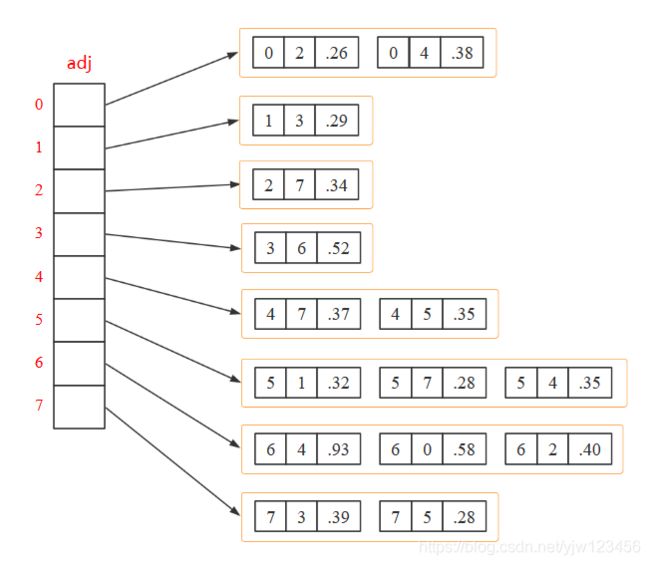图论算法——加权有向图的数据结构
引言
要解决最短路径问题,先引入加权有向图的数据结构。这和 加权无向图的数据结构很类似。
有关概念可参考博文数据结构之图的概述
加权有向边
package com.algorithms.graph;
/**
* @author yjw
* @date 2019/6/5/005
*/
public final class DirectedEdge {
/**
* 边的起点
*/
private final int v;
/**
* 边的终点
*/
private final int w;
/**
* 边的权重
*/
private final double weight;
public DirectedEdge(int v, int w, double weight) {
this.v = v;
this.w = w;
this.weight = weight;
}
public double weight() {
return weight;
}
public int from() {
return v;
}
public int to() {
return w;
}
@Override
public String toString() {
return String.format("%d -> %d(%.2f)", v, w, weight);
}
}
加权有向图
package com.algorithms.graph;
import java.util.HashSet;
import java.util.Set;
/**
* @author yjw
* @date 2019/6/5/005
*/
@SuppressWarnings("unchecked")
public class EdgeWeightedDigraph {
private final int vertexNum;
private int edgeNum;
private Set<DirectedEdge>[] adj;
public EdgeWeightedDigraph(int vertexNum) {
this.vertexNum = vertexNum;
this.edgeNum = 0;
adj = (Set<DirectedEdge>[]) new HashSet[vertexNum];
for (int v = 0; v < vertexNum; v++) {
adj[v] = new HashSet<>();
}
}
public int vertexNum() {
return vertexNum;
}
public int edgeNum() {
return edgeNum;
}
public void addEdge(DirectedEdge e) {
if (adj[e.from()].add(e)) {
edgeNum++;
}
}
public void addEdge(int start,int end,double weight) {
addEdge(new DirectedEdge(start,end,weight));
}
//提供增加边的便利方法
/**
* 以同一起点增加两条边
*/
public void addEdges(int start,int end1,double weight1,int end2,double weight2) {
addEdge(start,end1,weight1);
addEdge(start,end2,weight2);
}
/**
* 增加三条边
*/
public void addEdges(int start,int end1,double weight1,
int end2,double weight2,
int end3,double weight3) {
addEdges(start,end1,weight1,end2,weight2);
addEdge(start,end3,weight3);
}
/**
* 增加四条边
*/
public void addEdges(int start,int end1,double weight1,
int end2,double weight2,
int end3,double weight3,
int end4,double weight4) {
addEdges(start,end1,weight1,end2,weight2,end3,weight3);
addEdge(start,end4,weight4);
}
/**
* 增加五条边
*/
public void addEdges(int start,int end1,double weight1,
int end2,double weight2,
int end3,double weight3,
int end4,double weight4,
int end5,double weight5) {
addEdges(start,end1,weight1,end2,weight2,end3,weight3,end4,weight4);
addEdge(start,end5,weight5);
}
public Iterable<DirectedEdge> adj(int v) {
return adj[v];
}
public Iterable<DirectedEdge> edges() {
Set<DirectedEdge> set = new HashSet<>();
for (int v = 0; v < vertexNum; v++) {
set.addAll(adj[v]);
}
return set;
}
@Override
public String toString() {
StringBuilder s = new StringBuilder("(" + vertexNum + " vertices, " + edgeNum + " edges)\n");
for (int v = 0; v < vertexNum; v++) {
s.append(v).append(": ");
for (DirectedEdge e: this.adj(v)) {
s.append(e).append(" ");
}
s.append("\n");
}
return s.toString();
}
}
我们就来通过这个类构造上面这个图吧,构造代码:
EdgeWeightedDigraph g = new EdgeWeightedDigraph(8);
g.addEdges(0,2,.26,4,.38);
g.addEdge(1,3,.29);
g.addEdge(2,7,.34);
g.addEdge(3,6,.52);
g.addEdges(4,7,.37,5,.35);
g.addEdges(5,1,.32,7,.28,4,.35);
g.addEdges(6,4,.93,0,.58,2,.40);
g.addEdges(7,3,.39,5,.28);
System.out.println(g);
输出为:
(8 vertices, 15 edges)
0: 0 -> 2(0.26) 0 -> 4(0.38)
1: 1 -> 3(0.29)
2: 2 -> 7(0.34)
3: 3 -> 6(0.52)
4: 4 -> 5(0.35) 4 -> 7(0.37)
5: 5 -> 4(0.35) 5 -> 1(0.32) 5 -> 7(0.28)
6: 6 -> 4(0.93) 6 -> 0(0.58) 6 -> 2(0.40)
7: 7 -> 5(0.28) 7 -> 3(0.39)

